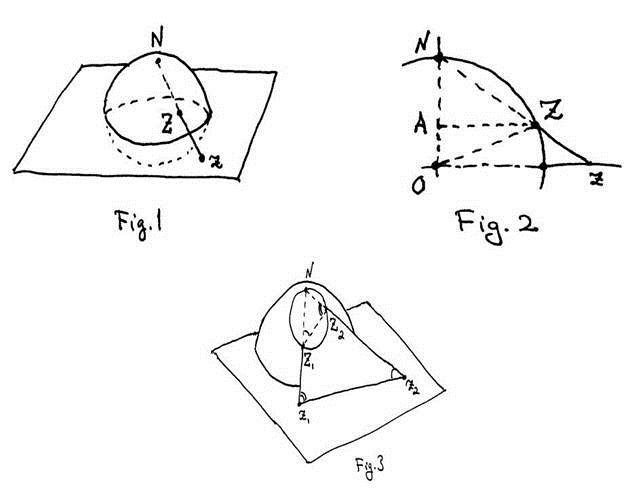Diferencia entre revisiones de «Compleja:z-ej-cap1.4»
Sin resumen de edición |
Sin resumen de edición |
||
| (No se muestran 4 ediciones intermedias de 2 usuarios) | |||
| Línea 2: | Línea 2: | ||
'''1.67. Usando la proyección estereográfica demuestre que la proyección de un círculo S en <math> \mathbb{S}</math> corresponde a un círculo T en el plano <math> \mathbb{C}</math>. Demuestre que si S contiene al polo norte, entonces su proyección T en <math> \mathbb{C}</math> es una recta.''' | '''1.67. Usando la proyección estereográfica demuestre que la proyección de un círculo S en <math> \mathbb{S}</math> corresponde a un círculo T en el plano <math> \mathbb{C}</math>. Demuestre que si S contiene al polo norte, entonces su proyección T en <math> \mathbb{C}</math> es una recta.''' | ||
Un círculo en S en <math> \mathbb{S}</math> es la intersección de un plano con la esfera, por lo que sus puntos satisfacen una ecuación de la forma <math>Ax+By+Cz=D</math>.<br/> | Un círculo en S en <math> \mathbb{S}</math> es la intersección de un plano con la esfera, por lo que sus puntos satisfacen una ecuación de la forma <math>Ax+By+Cz=D</math>.<br/> | ||
Por tanto este círculo es la imagen bajo la proyección estereográfica (2), satisfaciendo<br/> | Por tanto este círculo es la imagen bajo la proyección estereográfica (2), satisfaciendo<br/> | ||
<math>A \left ( \frac{2x}{1+|w|^2} \right ) + B \left ( \frac{2y}{1+|w|^2} \right ) + c \left ( \frac{|w|^2 -1}{1+|w|^2} \right ) = D, </math><br/> | <math>A \left ( \frac{2x}{1+|w|^2} \right ) + B \left ( \frac{2y}{1+|w|^2} \right ) + c \left ( \frac{|w|^2 -1}{1+|w|^2} \right ) = D, </math><br/> | ||
donde <math> w = (x,y,0), </math> por tanto <math>|w|^2=x^2+y^2 </math> <br/> | donde <math> w = (x,y,0), </math> por tanto <math>|w|^2=x^2+y^2 </math> <br/> | ||
<math>\Rightarrow 2Ax+2By+(x^2+y^2-1)C=D(1+x^2+y^2)</math><br/> | <math>\Rightarrow 2Ax+2By+(x^2+y^2-1)C=D(1+x^2+y^2)</math><br/> | ||
<math>\Rightarrow 2Ax+2By+Cx^2+Cy^2-C=Dx^2+Dy^2+D</math><br/> | <math>\Rightarrow 2Ax+2By+Cx^2+Cy^2-C=Dx^2+Dy^2+D</math><br/> | ||
<math>\Rightarrow (C-D)x^2+2Ax+(C-D)y^2+2By-(C+D)=0</math><br/> | <math>\Rightarrow (C-D)x^2+2Ax+(C-D)y^2+2By-(C+D)=0</math><br/> | ||
Si <math>C = D</math>, tenemos<br/> | Si <math>C = D</math>, tenemos<br/> | ||
| Línea 16: | Línea 23: | ||
Si <math>C \ne D</math>, completando cuadrados: <br/> | Si <math>C \ne D</math>, completando cuadrados: <br/> | ||
<math>x^2 + 2 \frac{A}{C-D} x + \left ( \frac{A}{C-D} \right )^2 + y^2 + 2 \frac{B}{C-D} y + \left ( \frac{B}{C-D} \right )^2 = \frac{C+D}{C-D} + \left ( \frac{A}{C-D} \right )^2 + \left ( \frac{B}{C-D} \right )^2 </math>.<br/> | <math>x^2 + 2 \frac{A}{C-D} x + \left ( \frac{A}{C-D} \right )^2 + y^2 + 2 \frac{B}{C-D} y + \left ( \frac{B}{C-D} \right )^2 = \frac{C+D}{C-D} + \left ( \frac{A}{C-D} \right )^2 + \left ( \frac{B}{C-D} \right )^2 </math>.<br/> | ||
<math> \Rightarrow \left ( x + \frac{A}{C-D} \right )^2 + \left ( y + \frac{B}{C-D} \right )^2 = \frac {(C+D)(C-D)+A^2+B^2}{(C-D)^2} = \frac{C^2-D^2+A^2+B^2}{(C-D)^2}</math>.<br/> | <math> \Rightarrow \left ( x + \frac{A}{C-D} \right )^2 + \left ( y + \frac{B}{C-D} \right )^2 = \frac {(C+D)(C-D)+A^2+B^2}{(C-D)^2} = \frac{C^2-D^2+A^2+B^2}{(C-D)^2}</math>.<br/> | ||
<math> \Rightarrow \left ( x + \frac{A}{C-D} \right )^2 + \left ( y + \frac{B}{C-D} \right )^2 = \frac{A^2+B^2+C^2-D^2}{(C-D)^2}</math>, la ecuación de un círculo con centro en <math>\left ( -\frac{A}{C-D},-\frac{B}{C-D} \right ) </math> y radio <math>r=\frac{\sqrt{A^2+B^2+C^2-D^2}}{C-D}</math>. | <math> \Rightarrow \left ( x + \frac{A}{C-D} \right )^2 + \left ( y + \frac{B}{C-D} \right )^2 = \frac{A^2+B^2+C^2-D^2}{(C-D)^2}</math>, la ecuación de un círculo con centro en <math>\left ( -\frac{A}{C-D},-\frac{B}{C-D} \right ) </math> y radio <math>r=\frac{\sqrt{A^2+B^2+C^2-D^2}}{C-D}</math>. | ||
--[[Usuario:Belen|Belen]] ([[Usuario discusión:Belen|discusión]]) 22:51 22 nov 2012 (CST) | ---- | ||
Realizado por: [[Usuario:Belen|Belen]] ([[Usuario discusión:Belen|discusión]]) 22:51 22 nov 2012 (CST) | |||
---- | |||
'''1.71.Si <math>\mathcal{Z_1}</math>,<math>\mathcal{Z_2}</math>, demuestre que''' | '''1.71.Si <math>\mathcal{Z_1}</math>,<math>\mathcal{Z_2}</math>, demuestre que''' | ||
| Línea 28: | Línea 38: | ||
[[Archivo:Variable | [[Archivo:Variable.jpg|cle]] | ||
| Línea 55: | Línea 65: | ||
--[[Usuario:Luis Antonio|Luis Antonio]] ([[Usuario discusión:Luis Antonio|discusión]]) 09:39 28 nov 2012 (CST) | ---- | ||
Realizado por: [[Usuario:Luis Antonio|Luis Antonio]] ([[Usuario discusión:Luis Antonio|discusión]]) 09:39 28 nov 2012 (CST) | |||
---- | |||
Revisión actual - 18:36 3 may 2023
La esfera de Riemann y el plano extendido
1.67. Usando la proyección estereográfica demuestre que la proyección de un círculo S en corresponde a un círculo T en el plano . Demuestre que si S contiene al polo norte, entonces su proyección T en es una recta.
Un círculo en S en es la intersección de un plano con la esfera, por lo que sus puntos satisfacen una ecuación de la forma .
Por tanto este círculo es la imagen bajo la proyección estereográfica (2), satisfaciendo
donde por tanto
Si , tenemos
, i.e., , la ecuación de una recta.
Si , completando cuadrados:
.
.
, la ecuación de un círculo con centro en y radio .
Realizado por: Belen (discusión) 22:51 22 nov 2012 (CST)
1.71.Si ,, demuestre que
.
Sea ,
Por triángulos semejantes y , implica .
Pero y , entonces
y
El plano N_z1z2, intersecta a S en un circulo,.
Vemos que,
los triangulos N_z1z2 y N_Z1Z2, son semejantes, entonces;
Hacemos
Realizado por: Luis Antonio (discusión) 09:39 28 nov 2012 (CST)


































